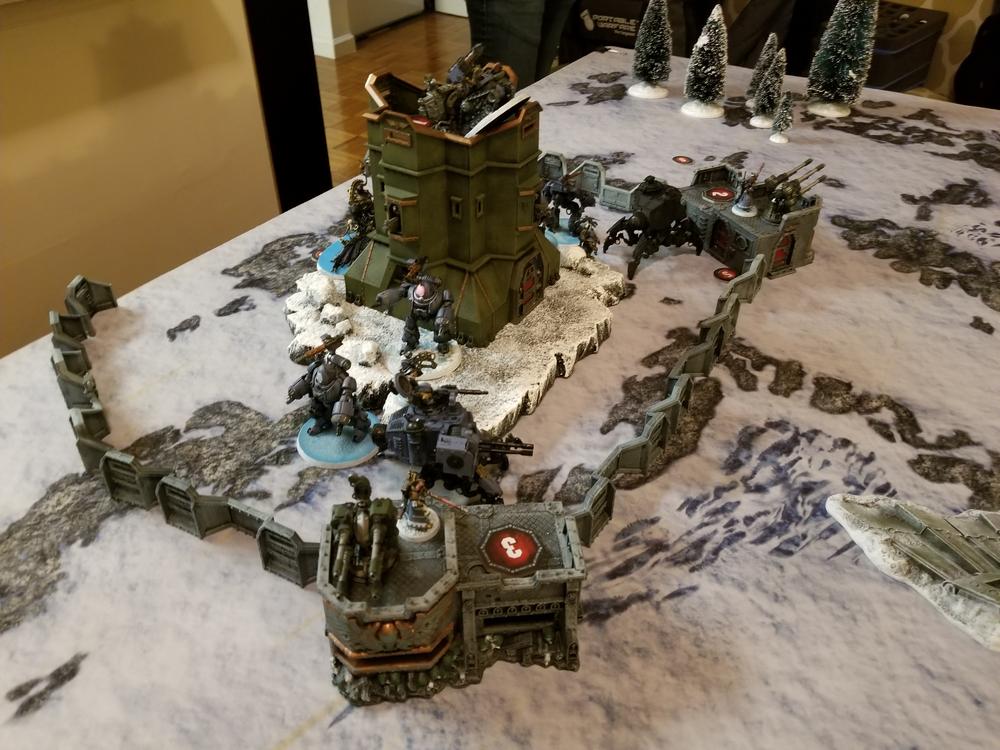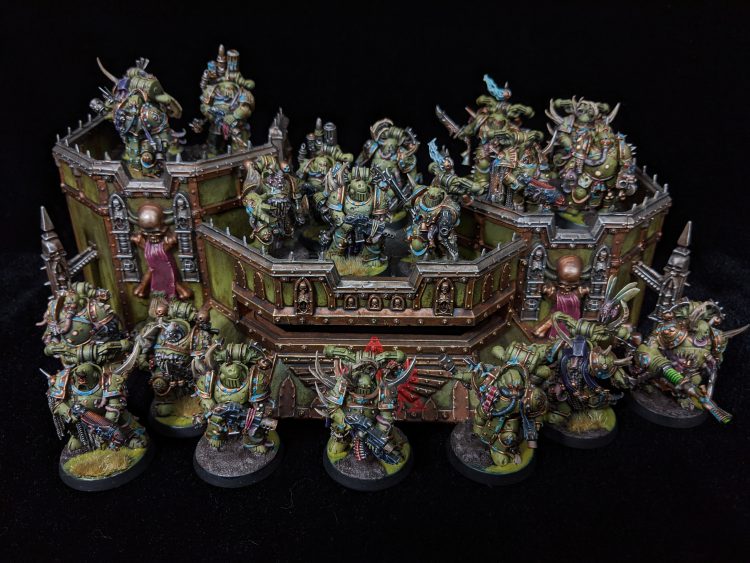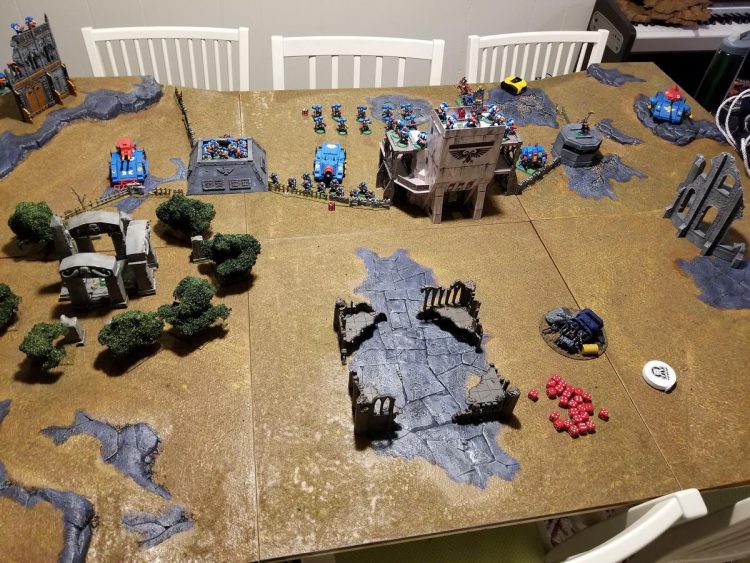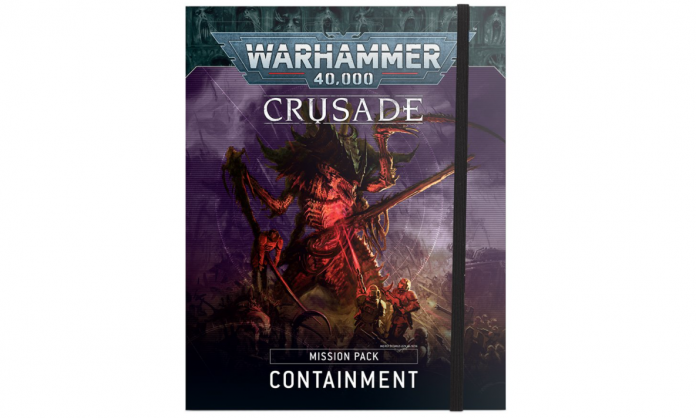As with the prior Campaign books for 9th edition 40k, Octarius book 1 comes with a companion Crusade tome, the Containment mission pack. As with prior Crusade packs, Containment gives us all new rules and missions for playing games in Warzone Octarius, along with new Stratagems, Agendas, and Battle Traits.
Beanith: It’s Planetstrike, you know the format almost no one liked playing in the previous editions because it was typically an unbalanced one sided beatdown on the defender. Can this game format be saved by Crusade?
TheChirurgeon: I’ve played more than a few games of Planetstrike, having run through the entire Planetary Onslaught campaign pack back in 7th and then the Planetstrike campaign again in 8th. I’m interested to see what they’ve done here, primarily because fortifications are normally just completely non-functional in 9th edition and it’s good to finally see missions that use them again. But yes, I’m a bit apprehensive.

The Planetstrike Mission Pack
The core mechanics of Containment revolve around playing Planetstrike campaigns. There’s a lot more going on with Planetstrike missions than the other mission packs, and these are the first truly asymmetrical mission pack that Games Workshop has released in 9th edition. Yes, we’ve had some attacker/defender missions before, but these take it to the next level – every mission determines an attacker and a defender right at the start – even before you muster an army. This is because in Planetstrike, the Attacker takes on the role of an invading army, dropping in from orbit, while the Defender takes on the role of a heavily dug-in defense force.
This carries through to affecting army construction: Attackers get CP refunded if their Warlord is part of an Outrider or Vanguard Detachment and they pay an extra CP to take Spearhead Detachments. Attackers also don’t get fortifications.
Defenders on the other hand get CP refunded if their Warlord is part of a Spearhead Detachment and they pay an extra CP to take Outrider Detachments. Their first Fortification Detachment costs 0 CP, doesn’t count towards their Detachment limit, and best of all, are free upto a certain power level depending on the Battle Size.
TheChirurgeon: FINALLY. It’s difficult to overstate how bad fortifications are in 9th edition and just making a few of them free for the Defender, who always has the second turn, is a decent trade-off, and allows the defender to hide key units away from alpha-striking attackers.
Beanith: Five Imperial Bastions in an Onslaught size game does sound interesting but for those three people who brought a Primaris Redoubt, it’s their time to dust off that chunk of resin and slap it down on the board.

Setting Up the Battlefield
Next up, players pick agendas from the Planetstrike Agenda list (more on that in a bit), and set up the battlefield. This is done entirely by the Defender, who can also set up all of their fortifications as long as these are set up wholly within their deployment zone. This ensures the Defender gets to lay things out however they want and also will have plenty of room to place their fortifications.
Starting the Game
There’s almost an entire page alone for Step 10. Declare Reserves and Transports and there’s a lot going on here. Attackers can put up to two thirds of their army into reserves and can put units into Strategic Reserves for free – 0 CP cost – and their Strategic Reserves can also attempt to arrive on the first turn of the game, and if a unit arriving from Strategic Reserves is INFANTRY, SWARM or BEAST or has FLY, it can drop in anywhere more than 9” from an enemy unit.
On the flip side, Defenders can only reserve up to one third of their army, and their reserves can never arrive on the first turn, even if they have Drop Pod Assault or some other ability that might let them. Both sides are also subject to Reserve rolls, a test that requires them to roll a D6 to see if the unit arrives. More on that in a bit.
Then, unless the mission briefing says otherwise, the Attacker typically gets first turn.
Finally, Planetstrike introduces a new mission rule: Max VPs, which limits how many Victory Points you can score from a specific objective. An example of this is that some objective might have ( Max 30 VPs) next to it, indicating that each player can only score a maximum of 30 victory points from it during that mission. This is mostly just to make bookkeeping easier.
TheChirurgeon: These rules haven’t changed a ton since the last iteration – the idea here is that the attackers are dropping down to the planet surface, and so many of their units will be arriving on the table turn 1 dropping all over the place. This can be a mixed bag – it gives the attacker lots of maneuverability, but also may mean that they arrive in pieces, allowing the defender to focus down and pick off key units as they arrive. This is one of the more difficult aspects of balancing Planetstrike games.

Planetstrike Mission Rules
Planetstrike games are a bit more complex than the standard game of 40k. Most of this is all set-up but there are a few additional things we need to manage. There are five major mechanics to Planetstrike missions to be aware of:
Reserve Rolls
Reserve Rolls are back and soon you’ll enjoy the sight of your opponent swearing at their dice as they roll so poorly that nothing shows up from reserves until the game is almost over in round four. Remember however that the dice gods are fickle and will quite happily rain on your parade too. Attacker units come in on a 3+ on turn 1 if they’re Fast Attack, Flyer, or Dedicated Transports (4+ otherwise), and this roll improves on later turns. The Defender has a similar deal, but their rolls start on turn 2 and are a bit harder.
Shock Tactics
Remember when we said that some unit types that the Attacker puts into Strategic Reserves can deep strike? The rule that does that is Shock Tactics. Shock Tactics changes up the Strategic Reserves rule for the Attacker to allow Infantry, Beast, Swarm or Fly to be set up anywhere on the battlefield more than 9” away from any enemy models.
Firestorms
The Attacker isn’t just dropping in – they’re bombing the hell out of the battlefield before their units head in, and to represent this, they get Firestorm Attacks before the battle starts. The number of Firestorm attacks the Attacker gets is depending on the total power ratings of all the Defender’s Fortifications, and starts at D3 and goes up from there. Firestorm Attacks are resolved like they were in 8th: The Attacker puts 6 markers numbered 1 through 6 on the table more than 9” apart and then for each Firestorm attack rolls a D6; each result tosses out a bunch of mortal wounds to anything within 6” of the marker you rolled.
This essentially is one way the rules make up for a potentially large points disparity between the two armies, and gives the Attacker a way to crack the defender’s shell a bit. There’s also a cool additional rule here for Genestealer Cult Ambush markers that tells you what to do if an Ambush marker is hit and allows GSC to reduce the number of mortals they take arriving from a marker that was hit.
Planetary Control
The “lock-in” mechanic for objective control in Sweep & Clear and Vital Intelligence has been ported to Planetstrike, where you retain control of an objective after you leave it if you control it at the end of your Command phase. Also, all of the objectives start under Defender control.
Strongholds
You can put objective markers into your fortifications! Doing so transforms them into STRONGHOLDS, and basically turns the whole thing into an objective marker. Blowing up the building then causes the objective marker to fall out.
TheChirurgeon: These aren’t too bad as far as rules go; they’re pretty easy to remember and most of them deal with reserves or are handled before the game starts. This makes them pretty easy to handle, and they make for a decent mission setup.

Planetstrike Stratagems
Planetstrike gives players access to new Stratagems – 8 each for the Attacker and the Defender. The Attacker Stratagems tend to focus on blowing things up and getting more of your units to the battlefield early, while the defender Stratagems mess up the opponent’s Firestorm attacks and can help get your own reserves on to the table quickly. My favorite of these is the Attacker Stratagem Laserburn (2 CP), which has a player draw a line between two FIrestorm markers and then anything between them takes mortal wounds as a massive orbital laser burns a trench into the ground.
Planetstrike Agendas
Planetstrike gives us 8 Agendas, 4 for Attackers and 4 for Defenders. The Attacker agendas reward destroying things and capturing objectives; the defender agendas reward holding objectives and keeping units alive. They’re all pretty decent. Coordinate the Defence is a defender agenda that scores you XP for having a character perform an action in the middle of the battlefield, and if it’s your warlord doing it, each time you perform the action you roll a D6 and on a 4+, you gain a Command Point. It’s neat, particularly considering the center of the board may be a fortified stronghold for you.
Planetstrike Battle Traits
There are battle traits for Attackers and Defenders as well, additional rewards that you can gain during Planetstrike games. These are decent but tend to be very focused on Planetstrike games, to the point that I’m not sure you’d want them if you weren’t planning to get stuck in for a long Planetstrike campaign. The Attacker Trait Masters of Timing lets you treat the battle round as 1 higher when arriving from Strategic Reserves and gives you +1 to reserves rolls. Interesting normally but only great in Planetstrike. Most of them are like that.
Pankallis Assault Campaign
The missions and rules in Containment are designed in part to link back to the campaign rules in Warzone: Octarius book 1, and the Crusade book gives advice on how to build campaign trees for campaigns of various sizes, giving you win and loss paths throughout. These are pretty helpful guides, and are set up in three-phase maps, with players playing best-of-three game rounds to determine how they’ll move to the next round.

Planetstrike Missions
As with other Crusade books, Planestrike gives us 3 Combat Patrol, 6 Incursion, 6 Strike Force, and 6 Onslaught missions to choose from.
Rob: These offer some interesting narrative structures, and I like how they’ve been set up. The Combat Patrol missions feel appropriately sized for what they are, with Vanguard Operations feeling like a small force attempting a covert op against Defenders who can score VP by raising the alarm and Evac Under Fire seeing the Defenders attempting to flee an attacking force with a valuable relic.
The larger missions do more to capture the hectic nature of an invading force making planetfall, like the Strike Force mission of the same name that plays more like a traditional game but with a fortified position. Forlorn Hope on the other hand sees the defender protecting their general’s banners from attackers looking to raze them. And in Planetquake, all hell breaks loose and earthquakes rock the battlefield as a result of planetary damage sustained during the war.
Final Thoughts
Rob: In all the new Crusade pack is a mixed bag. In some ways it’s a letdown from Amidst the Ashes, which introduced a host of really cool rules and upgrades that had us gushing in favor of reworking the Planetstrike Rules we’ve already seen on multiple occasions. That said, the latest iteration of these rules seems to be the most solid yet, and Planetstrike offers more asymmetrical gameplay than any supplement that’s come before.
Ultimately, your mileage on this one is going to come down to how you feel about asymmetrical games and fortifications. If you like the idea of being given a reason to play with Fortifications – and some of them just got new datasheets in Warzone: Octarius – then this is going to give you the best possible excuse to break them out and play with them. If you’re less enthusiastic about them, or just prefer symmetrical games, then this isn’t going to be for you. But I have a soft spot for siege warfare and playing games against foes in defended positions and I’ll likely be bringing these rules into a future campaign.
Have any questions or feedback? Shoot us an email at contact@goonhammer.com.


